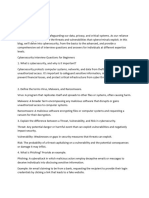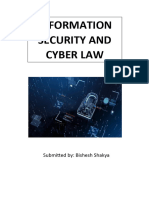0% found this document useful (0 votes)
4 views2 pagesCybersecurity Interview QA
The document outlines key concepts in cybersecurity, including encryption types, firewall functions, and the CIA triad. It also covers various cyber threats, prevention strategies, and the importance of user training and incident response. Additionally, it emphasizes the need for strong password policies and multi-factor authentication for enhanced security.
Uploaded by
Oroxie Ebi PraizeCopyright
© © All Rights Reserved
We take content rights seriously. If you suspect this is your content, claim it here.
Available Formats
Download as PDF, TXT or read online on Scribd
0% found this document useful (0 votes)
4 views2 pagesCybersecurity Interview QA
The document outlines key concepts in cybersecurity, including encryption types, firewall functions, and the CIA triad. It also covers various cyber threats, prevention strategies, and the importance of user training and incident response. Additionally, it emphasizes the need for strong password policies and multi-factor authentication for enhanced security.
Uploaded by
Oroxie Ebi PraizeCopyright
© © All Rights Reserved
We take content rights seriously. If you suspect this is your content, claim it here.
Available Formats
Download as PDF, TXT or read online on Scribd
/ 2





















































